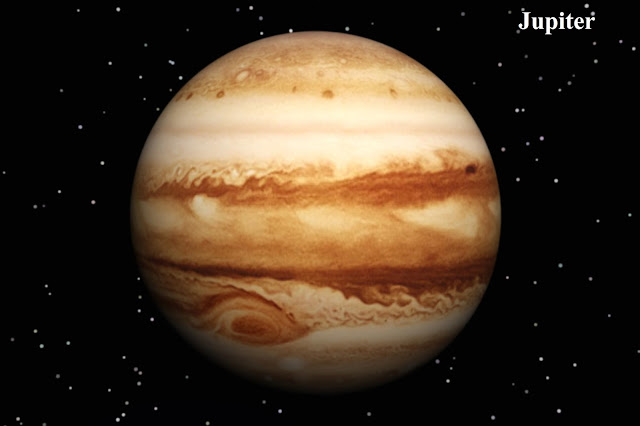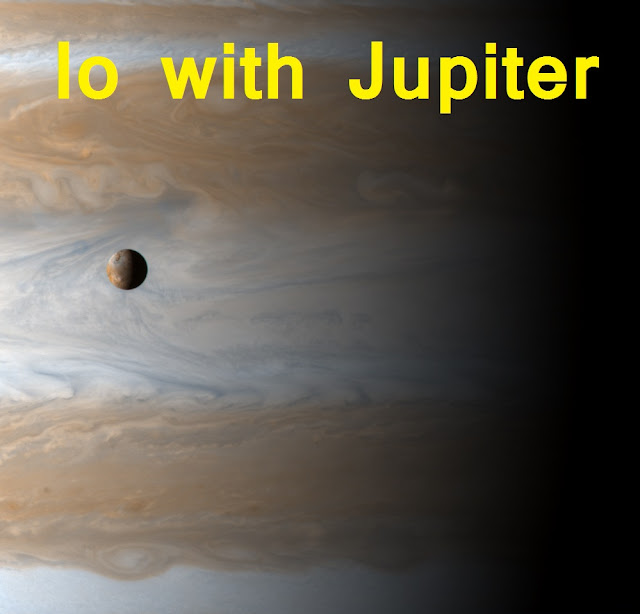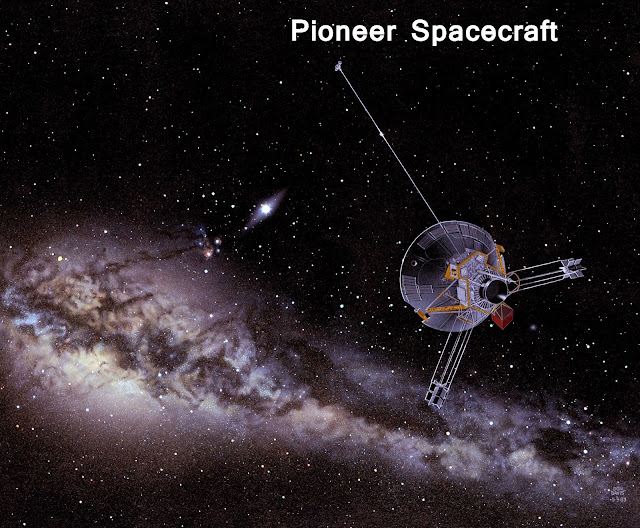Among the various planets and satellites of this solar family, there are some places that have been able to differentiate themselves from others for their own uniqueness. One such place is the nearest satellite to Jupiter, Io

Galileo
Galilei is one of the best astronomers of the European Renaissance. The four
satellites, he discovered on Jupiter, are called the Galilean moons. The third
largest of these four is this satellite which contains hundreds of volcanoes.
If we talk about the whole solar family, it is the fourth largest satellite
which is slightly bigger in size than the moon, the only satellite of our
earth.
On
7th January 1610, Galileo first saw Io from the Padua University, Italy.
However, Galileo did not distinguish between the two moons of Jupiter, Io and
Europa, in order to position them at the same point of view from earth. The
next day, 8th January, they were seen separately and the International
Astronomical Union (IAU) has recognized that day as the day of the discovery of
Io. Another German scientist, Simon Marius, discovered Io seven days earlier,
but Galileo was credited because the information of discovery of Io was first
published by Galileo. At that time the name of this satellite was Galileo-I.
Later, on the advice of another German scientist Johannes Kepler, Simon Marius
named the newly discovered satellite after Io, the daughter of the mythological
river Inachus, the priestess of Hera, and one of the lovers of Zeus.



For
a long time after the discovery, no observations or research was done on Io.
After 1890, American scientist Edward Bernard first noticed the difference in
brightness in polar and equatorial region of Io. There are reddish brown polar
regions and yellowish white equatorial regions. Then, in the middle of the
twentieth century, it has discovered that instead of having an icy surface like
other satellites, it has the surface, covered by various compounds of sodium
and sulfur, and even, scientists speculated that, this may contain the least
water molecule among all the planets and satellites in the solar system.

The
densest satellite in the solar system, orbits Jupiter at an average speed of
62,423 km per hour from the average distance of 4,21,700 km from Jupiter in
42.5 hours. This satellite is tidally locked with Jupiter, meaning that a part
of this satellite is always faced towards Jupiter, or in other words, the
diurnal motion and the annual motion of Io are equal. Io's escape velocity is
2.56 km per second or 8,552 km per hour. (Escape Velocity: The
minimum velocity that a moving body must have to escape from the gravitational
field of a celestial body) The part of Io that is always towards Jupiter is
called the Sub-Jovian Hemisphere, the part that is farther away from Jupiter is
called the Anti-Jovian Hemisphere, the part that is moving along the orbit is
called the Leading Hemisphere and the part that is opposite the orbit is called
the Trailing Hemisphere.

Io
has an effective role behind the active magnetic field of Jupiter that we know
of. Jupiter's gravitational force moves ionized gaseous particles and atoms of
elemental and composite matter towards it. All of these substances are usually
caused by volcanic eruptions and these particles surround Io, forming a light
cloud-like canopy that can extend up to six times the radius of Io. Some of
these particles go to Jupiter's orbit, revoking the gravitational force of Io. In
addition, Jupiter's magnetic field has created its own aurora at its polar
region as well as the equatorial region of Io.
The satellite, which is 21 percent larger than the Moon, is
not entirely spherical but rather slightly elliptical, and Jupiter's intense
gravitational force is entirely responsible for this. The interior of Io is
made up of silicate rocks and iron. The core of the centre consists of 20
percent of the total mass of the Io. There is a clear boundary between this core
and the mantle that surrounds it. However, there is still a mysterious fog
about the exact diameter. If this core is made of iron only, its diameter will
be between 350 km to 650 km. But if the core contains sulphur along with iron,
then the diameter of that core will be 550 km to 950 km. The mantle of Io is
made up of at least 75 percent magnesium-rich minerals and 10 to 12 percent of
it is molten. A 2011 study found that the Io mantle is made up of 50 km deep
Magma Sea with a temperature of about 1,200 degree Celsius. This magma layer is
responsible for the magnetic field of Io. The gravitational force of Jupiter,
Ganymede and Europa is largely responsible for the high temperature and
instability inside Io. About 20,000 times as much force as the earth is
attracted to by the moon is always applied to Io. The expression of this warmth
is expressed through the activity of volcanoes. The crust of Io is 12 km to 40
km deep and is composed of solid basalt and silicate.

Evidence
that the surface of Io is geologically younger than other planets or satellites
is almost absence of craters due to cosmic collision on its surface. Even if there
is any dent due to cosmic collision, the molten lava from the eruption covers
it. For this reason the surface of Io is composed of frozen sulphur or sulphur
dioxide. As far as observations are concerned, there are more than 400 active
volcanoes in Io, with lava erupting as high as 200 km or even 500 km above the
Io's surface. The intense attraction of Jupiter and other Galileon moons is the
cause of geological instability and the birth of so many volcanoes on Io's
surface. Due to the lava and ash, created by volcanic eruptions, the presence
of various colours can be seen on the surface here, which is mainly derived
from sulphur. However, the effect of radiation has created other substances in
many places. On the surface of Io, there are some volcanic holes, which are
called Paterae. Although there are many theories about its origin, nothing can
be said for sure yet. One of them is Loki Paterae. This Loki is the most
powerful volcano in Io, providing 25 percent of Io's total heat. There is also
another volcano called Pele. Lava flows, basically basalt nature, have also
been named on the surface of Io. Notable among them are Prometheus, Masubi and
Amirani. The temperature of these lava flows can range from 1,300 Kelvin to
1,700 Kelvin (1,027 degree Celsius to 1,376 degree Celsius). The maximum speed
of these lava flows reaches 1 km per second or 3,600 km per hour. Here height
of the volcanoes can range from 1,000 mtr to 2,000 mtr.

The
intense contraction inside the silicate surface of Io has resulted in the
formation of hundreds of mountains on its surface. Its altitude ranges from
6,000 mtr to more than 18,000 mtr. Some of these peaks are higher than Mount
Everest, the highest point of the world. Probably the highest mountain on the
surface of Io is Boösaule montes (18,200 mtr). The range of these mountains can
be more than 157 km. However, in the areas of Io where these folded mountains
have formed, the presence of volcanoes is usually very low. It is true that
erosion can be seen in all types of mountains. The presence of plateaus has
also been found in the mountain range of Io.

Water
molecules were not found in Io in that sense. Scientists estimate that if there
may be water particles, it may have been near a mountain called Gish Bar Mons.
When Jupiter was very hot in its initial stage, almost all water molecules were
blown away from Io due its proximity to Jupiter.

The
atmosphere of Io is very thin and has extremely disproportionate densities due
to the high activity of volcanoes. The density of this thin atmosphere varies
depending on the eruption, time and latitude. So if a spacecraft lands here in
the future, it will not have to face more problems with the atmosphere, but the
intense radiation of Jupiter can cause a variety of problems. This atmosphere
contains sulphur dioxide, sulphur monoxide, molecular sulphur and oxygen. An
average of 104 kg of sulphur dioxide is released into the atmosphere of Io
every second through volcanoes, most of which return to the surface of Io.
Scientists’ estimate that every time Io moves behind Jupiter, its weather freezes
and moves to the surface. So when Io comes out from behind Jupiter, the first
15 minutes show it very bright. The average surface temperature of Io is about
-202 degree Fahrenheit or -130 degree Celsius.

Expeditions
to Io have been carried out more than once by spacecrafts. The first expedition
took place on 3rd December 1973. On that day, Pioneer 10 made its flyby
3,56,000 km from Io (Flyby: According to the space science, the shortest distance, at the time of
observation, between observation space vehicle and the planet or satellite.).
Exactly one year after that event, the Pioneer-11 made its flyby 3,14,000 km
from Io. These two spacecraft first gave us an idea of the Io's surface, thin
atmosphere, and radiation. Then, on March 5, 1979, the Voyager-I spacecraft
made its flyby just 20,100 km from Io. At that time, we could learn about the
colour of the surface and the absence of dents in it, about the lava flow and
about the mountain peaks higher than Mt. Everest. Four months later, on 8th
July 1979, the Voyager II spacecraft flew 11,29,900 km from Io. At that time we
learned of a large number of volcanoes on the surface of Io. [For more
information on the Voyager mission please visit the article 'Voyager, The
Oldest Surviving Space Mission'. The link of the article is: https://spacejagat.blogspot.com/2020/02/voyeger.html]


In
1995, 16 years after the Voyager mission, the Galileo spacecraft reached Io and
made total 7 flybys over it. However, in this case, the intense radiation of
Jupiter caused various problems. So this spacecraft had to face a lot of
difficulties to take pictures from very close to Io. Yet it had detected the
presence of ion particles, surrounding Io, collected the information about
magnesium and silicate-rich lava eruption and explored the mountain ranges of
different heights.

In
addition, the Cassini-Huygens spacecraft did not escape the attention of Io
during its journey to Saturn. On 30th December 2000, the spacecraft observed
the volcanoes of Io and sent information to earth. On 28th February 2006, the
Kuiper-bound New Horizon spacecraft observed a 290 km high eruption of the
Tvashtar volcano near the North Pole of Io and was captured on camera. The
spacecraft also sent information and images of some of Io's volcanoes to earth.



The
last spacecraft to reach Io so far is the Juno. On 25th February 2020,
the spacecraft spotted Io from the distance of 1,95,000 km. Then on 30th
December 2023 and 3rd February 2024 this spacecraft will make its flyby over Io
twice more. Apart from this, according to the plan, from July 2022 to May 2025,
this Juno spacecraft will make flyby 9 more times from the distance of 11,500
km to 94,000 km to Io and will try to know better about the changing nature of
surface of Io and its gravitational force. So far, however, the spacecraft has
been monitoring the eruption of volcanoes and its heat dissipation and trying to
map the configuration of land of Io.

So
far, two missions have been announced for Io. The first is the European Space
Agency's JUICE (The Jupiter Icy Moon Explorer), which will begin in 2022 and
arrive in Io in October 2029. The spacecraft will be enriched with more
sophisticated equipment and will go a little closer to Io and observe the
activity and surface structure of the volcano. This will be followed by the
launch of the Europa Clipper mission by NASA in 2025 and will probably reach
its destination after 2030. In addition, another NASA mission is now at the table
of discussion in its infancy. According to the initial plan, a spacecraft named
Iyo Volcano Observer will be launched in 2029, which will reach Io in the
mid-2030s. This spacecraft will make at least 10 flybys over Io and send information
to the earth.



Io's identity and importance is not confined among Jupiter's many satellites as a volcanic satellite, but much more. Io's discovery has become a milestone in the advancement of astronomy. This discovery established for the first time the model of the heliocentric solar family of the German mathematician and astronomer Nicolas Copernicus, proved the authenticity of the Johannes Kepler's law of planetary motion, and advanced the measurement of the speed of light. It is one of the proven fact that, the place which is totally unsuitable for human habitation has made the path of science journey of human easier, pointing the new direction in space exploration.

DECLARATION: All The Images Have Been Sourced From Google.
